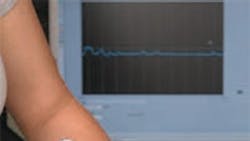Oh, baby! Device measures delivery force
When the birth of a baby does not proceed smoothly, how much force should a doctor or midwife apply? If a complicated delivery takes too long, the child could suffocate, yet pulling too hard could injure the child.
To address this dilemma, Johns Hopkins University biomedical engineering students invented a device that measures the amount of force a doctor or midwife uses while delivering a baby. A wireless transmitter sends the data from the doctor to a computer across the room. The system is being tested at Johns Hopkins Hospital, where researchers hope it will help identify the safest delivery method for a complicated birth. The inventors believe the device also could be used as a teaching tool, helping obstetricians- in-training learn how to assess the amount of force they use during a routine delivery.
The electromyographic instrument, which measures electrical impulses in the muscles of the forearm, was devised and constructed by a team of undergraduates during a semester-long biomedical engineering design team course. Based on this achievement, four team members were selected as finalists in 2003’s Collegiate Inventors Competition, sponsored by the National Inventors Hall of Fame in Akron, Ohio. The Johns Hopkins device was one of six undergraduate projects to become finalists.
Robert Allen, a senior lecturer in the Department of Biomedical Engineering, and his obstetrics research colleagues have been looking for a method of measuring the force used in a delivery as a way to determine the best technique to employ during complicated births. Previously, inventors have placed sensors in gloves, or on the hands, interfering with doctors’ grasp. Allen’s students came up with a less intrusive system, in which three electrodes are attached to the forearm and connected to a small metal box that rests in the doctor’s pocket. The box collects information from the electrodes and transmits it to a receiver up to 50 ft away. The receiver is connected to a laptop computer that stores and processes the data.
Edith Gurewitsch, assistant professor of gynecology and obstetrics in the Johns Hopkins School of Medicine, has supervised an institutional review board-approved pilot study, testing the device during 15 deliveries performed by physicians and a midwife. The participants wore the electrodes under sterile gowns and gloves. The device was also used in a lab in which mock deliveries were performed using a baby-sized doll.
Generally, physicians or midwives apply minimal force on the child during a routine delivery. Gurewitsch hopes to use the student- built device in her study of complicated deliveries in which the baby’s shoulder becomes stuck behind the pubic bone.
The device is calibrated to each user, either shortly before or after the delivery, when the physician or midwife’s forearm muscle impulses are recorded at rest and while pulling with 5 lb of force, then 10 lb, as measured by a dynamometer. The device can then produce an accurate record of the force used during delivery by comparing it to the calibration readings.
Beyond the delivery room, the student inventors believe the device could be used for training and research in orthopedic surgery, which can require the use of great force, and in preventing sports injuries. For example, a baseball pitcher might use the device to learn how to throw with considerable force, but not enough to cause an injury.
The four students and Allen obtained a provisional patent covering their device. The students are William Tam of Boston, Yen Shi Hoe and I-Jean Khoo of Singapore, and Stanley Huang of Toronto.
